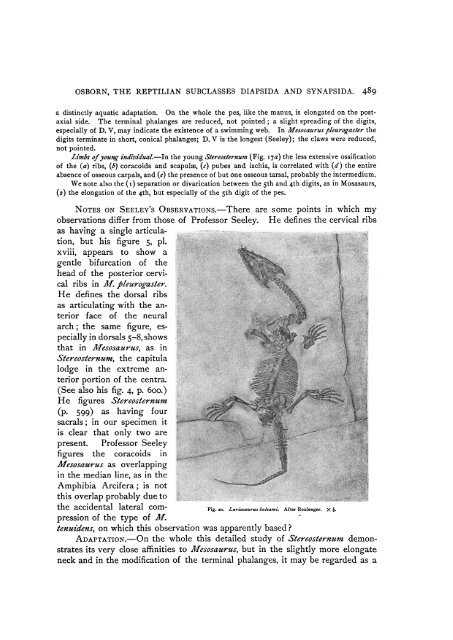American Museum of Natural History
American Museum of Natural History
American Museum of Natural History
Create successful ePaper yourself
Turn your PDF publications into a flip-book with our unique Google optimized e-Paper software.
OSBORN, THE REPTILIAN SUBCLASSES DIAPSIDA AND SYNAPSIDA. 489<br />
a distinctly aquatic adaptation. On the whole the pes, like the manus, is elongated on the postaxial<br />
side. The terminal phalanges are reduced, not pointed; a slight spreading <strong>of</strong> the digits,<br />
especially <strong>of</strong> D. V, may indicate the existence <strong>of</strong> a swimming web. In Mesosauruspleurogaster the<br />
digits terminate in short, conical phalanges; D. V is the longest (Seeley); the claws were reduced,<br />
not pointed.<br />
Limbs <strong>of</strong>young individuaL-In the young Stereosternum (Fig. 17a) the less extensive ossification<br />
<strong>of</strong> the (a) ribs, (b) coracoids and scapulae, (c) pubes and ischia, is correlated with (d) the entire<br />
absence <strong>of</strong> osseous carpals, and (e) the presence <strong>of</strong> but one osseous tarsal, probably the intermedium.<br />
We note also the (X) separation or divarication between the 5th and 4th digits, as in Mosasaurs,<br />
(2) the elongation <strong>of</strong> the 4th, but especially <strong>of</strong> the 5th digit <strong>of</strong> the pes.<br />
NOTES ON SEELEY'S OBSERVATIONs.-There are some points in which my<br />
observations differ from those <strong>of</strong> Pr<strong>of</strong>essor Seeley. He defines the cervical ribs<br />
as having a single articulation,<br />
but his figure 5, plxviii,<br />
appears to show a<br />
gentle bifurcation <strong>of</strong> the<br />
head <strong>of</strong> the posterior cervical<br />
ribs in AM. pleurogas/er.<br />
He defines the dorsal ribs<br />
as articulating with the anterior<br />
face <strong>of</strong> the neural<br />
arch; the same figure, especially<br />
in dorsals 5-8, shows<br />
that in M*esosaurus, as in<br />
Stereosternum, the capitula<br />
lodge in the extreme an- n<br />
tenor portion <strong>of</strong> the centra.<br />
(See also his fig. 4, p. 6oo.)<br />
He figure's Stereosternum<br />
(P. 599) as having four<br />
sacrals;iou specimen it<br />
is clear that only two are<br />
present. Pr<strong>of</strong>essor Seeley<br />
figures the coracoids in<br />
Mesosaurus as overlapping<br />
in -the median line, as in the<br />
Amphibi'a Arcifera; is not<br />
this overlap probably due to<br />
the accidental lateral corn- Fig. 20. Lariosaurus tbalsamz. After Boulenger. X J.<br />
pression <strong>of</strong> the type <strong>of</strong> AL.<br />
tenuidens, on which this observation was apparently based?<br />
ADAPTATION.-On the whole this detailed study <strong>of</strong> Stereos/ernum demonstrates<br />
its very close affinities to Mesosaurus, but in 4the slightly more elongate<br />
neck and in the modification <strong>of</strong> the termninal phalanges, it may be regarded as a<br />
Z

















